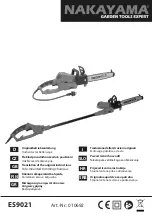
4
ENGLISH (Original instructions)
Explanation of general view
1-1. Red indicator
1-2. Button
1-3. Battery cartridge
2-1. Star marking
3-1. Lever
4-1. Lever
5-1. Stopper
6-1. Base
6-2. Cutting line
7-1. Switch trigger
7-2. Lock-off lever
8-1. Shaft lock
8-2. Hex wrench
9-1. Inner flange
9-2. Saw blade
9-3. Outer flange
9-4. Hex. bolt
10-1. Inner flange
10-2. Saw blade
10-3. Ring
10-4. Outer flange
10-5. Hex bolt
11-1. Hex wrench
12-1. Dust nozzle
12-2. Screw
13-1. Hose
13-2. Vacuum cleaner
14-1. Rear handle
14-2. Front grip
14-3. Base
15-1. Clamping screw
15-2. Rip fence (Guide rule)
16-1. Adjusting screw for 45
゚
(DSS610 only)
16-2. Adjusting screw for 90
゚
17-1. Triangular rule
18-1. Limit mark
19-1. Brush holder cap
19-2. Screwdriver
SPECIFICATIONS
Model DSS610
DSS611
Blade diameter
165 mm
at 90°
57 mm
at 45°
40 mm
Max. Cutting depth
at 50°
36 mm
No load speed (min
-1
) 3,700
Overall length
347 mm
Net weight
3.5 kg
3.3 kg
Rated voltage
D.C. 18V
• Due to our continuing program of research and development, the specifications herein are subject to change without notice.
• Specifications and battery cartridge may differ from country to country.
• Weight, with battery cartridge, according to EPTA-Procedure 01/2003
ENE028-1
Intended use
The tool is intended for performing lengthways and
crossways straight cuts and mitre cuts with angles in
wood while in firm contact with the workpiece.
ENG905-1
Noise
The typical A-weighted noise level determined
according to EN60745:
Sound pressure level (L
pA
) : 78 dB (A)
Uncertainty (K) : 3 dB (A)
The noise level under working may exceed 80 dB (A).
Wear ear protection
ENG900-1
Vibration
The vibration total value (tri-axial vector sum)
determined according to EN60745:
Work mode : cutting wood
Vibration emission (a
h,W
) : 2.5 m/s
2
or less
Uncertainty (K) : 1.5 m/s
2
ENG901-1
•
The declared vibration emission value has been
measured in accordance with the standard test
method and may be used for comparing one tool
with another.
•
The declared vibration emission value may also be
used in a preliminary assessment of exposure.
WARNING:
•
The vibration emission during actual use of the
power tool can differ from the declared emission
value depending on the ways in which the tool is
used.
•
Be sure to identify safety measures to protect the
operator that are based on an estimation of
exposure in the actual conditions of use (taking
account of all parts of the operating cycle such as
the times when the tool is switched off and when it
is running idle in addition to the trigger time).





































